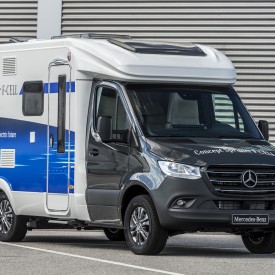Mercedes-Benz Vans is set to enhance the eDrive@VANs strategy with the fuel cell. Using the example of a semi-integrated motorhome, the Concept Sprinter F-CELL illustrates the full breadth of the characteristic benefits of a fuel cell from long range to zero-local-emissions mobility.
Scroll down for more photos.
When it comes to selecting the right powertrain concept, Mercedes-Benz Vans is thus focusing even more on the individual application, making it more customer dependent than ever. Aside from the vehicle technology, a comprehensive evaluation must take into account system weight, charging or refueling time, range and economy.
“We will offer every commercial range with an electric drive – starting this year with the eVito and in 2019 with the eSprinter,” said Volker Mornhinweg, head of Mercedes-Benz Vans. “With these, we will already cover many, but not all, use cases with a zero-local-emissions powertrain. For this reason, we are enhancing our eDrive@VANs strategy with fuel-cell drive, which offers substantial medium-term opportunities, especially in long-distance operation – regardless of whether a fuel-cell vehicle is used as a motorhome or in other commercial applications.”
The interaction of battery and fuel cell drives in the Concept Sprinter F-CELL delivers an electric output of around 147 kilowatts and torque of 350 newton meters. The three tanks in the substructure can store a total of 4.5 kilograms of hydrogen, enough for a range of around 300 kilometers.
If a longer range is required for a specific use, the hydrogen tanks integrated into the vehicle underbody can be supplemented by another in the rear. This configuration lifts the range to as much as 500 kilometers. Like the GLC F-CELL, the Concept Sprinter F-CELL also combines innovative fuel cell and battery technology to create a plug-in hybrid. Alongside hydrogen, it can also be “refuelled” with electricity, raising the range by up to 30 kilometers.
The structure of the Concept Sprinter F-CELL with rear-wheel drive and a comparably low system weight creates flexibility for additional bodies and conversions. The modular system means the fuel cell can establish itself as an alternative to conventional and battery-electric drives for use on shorter routes in as many use cases as possible.
